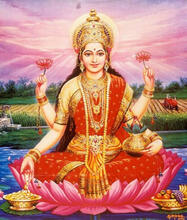
The main Diwali celebration occurs on the night of the new moon which occurs on November 14 this year. On this auspicious day most Hindus worship a form of the feminine Divine: either Maha Lakshmi, the Goddess of wealth and well-being or Maha Kali, Her more intense aspect. Wealth, for many people, equates to material success and this is one aspect of the abundance represented by Maha Lakshmi. Thus, Diwali marks the closing of the fiscal year for many businesses in India.
Yet Hindu scriptures caution that material wealth may be fleeting and should be accrued, conserved and charitably dispensed for the purposes of communal as well as familial flourishing. Lakshmi’s own origin story points to the need to include charitable giving such that wealth does not lead to disruption in one’s life.
Lakshmi’s appearance is described in a sacred story beloved by Hindus, the Samudra Manthan or churning of the Milky Ocean. Less well known is that Lakshmi has an older sister Alakshmi, who is Her opposite and appeared out of the Milky Ocean before Her sister. This Goddess of discord always seeks to exist beside Her younger sister, bringing Her tension along with Lakshmi’s blessings of prosperity. We certainly seek abundance in our lives, yet at the same time we seek to avoid strife. The solution, according to our scriptures, is dāna. It is through charitable giving that we retain Lakshmi in our households while keeping Her elder sister Alakshmi at bay. Diwali is therefore considered a particularly auspicious time for charitable donations.
Dr. Asha Shipman
November 2020